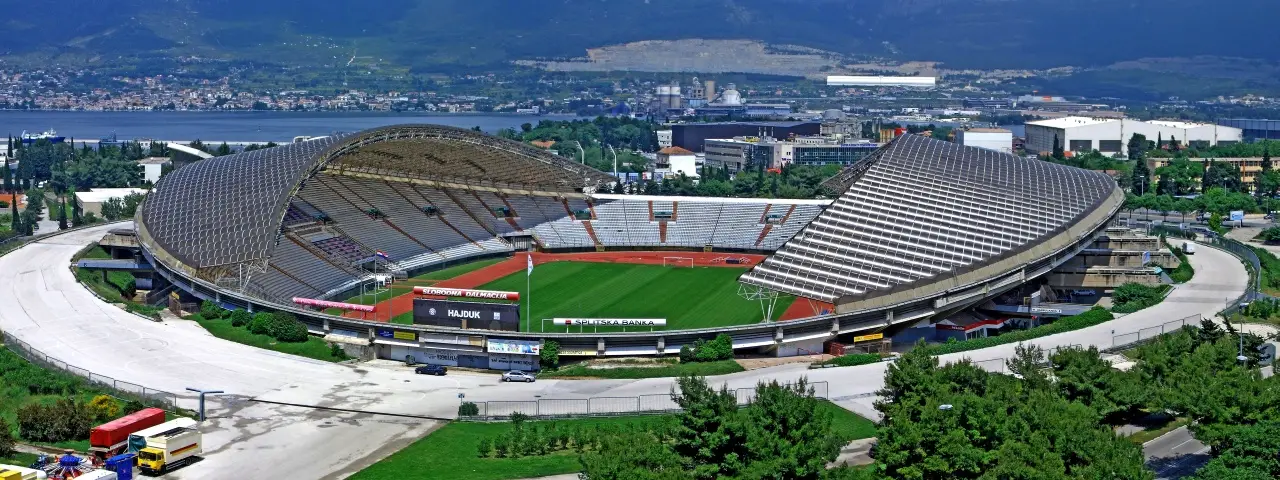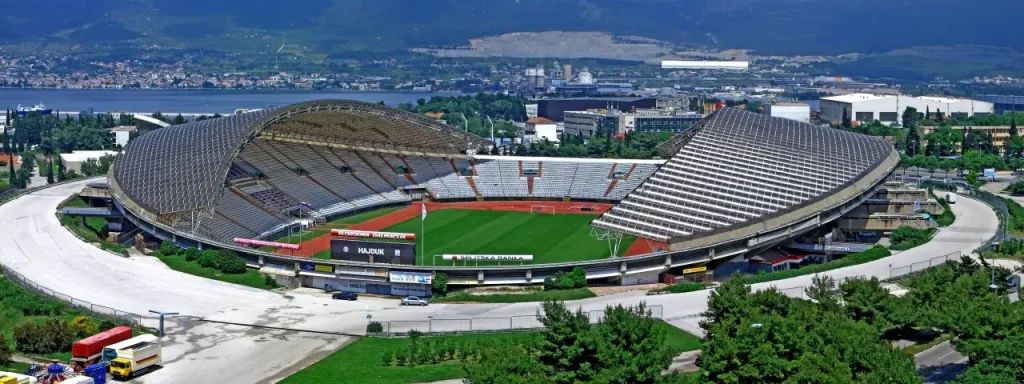
September 6, 2020 – Poljud celebrates 41 years. Retired professor Ante Mihanovic from the Faculty of Civil Engineering, Architecture and Geodesy in Split spoke about the condition of the stadium after so many years, how it could look in a new guise, and how long the renovation works could last.
Slobodna Dalmacija writes Poljud stadium, the work of architect Boris Magas, is celebrating its 41st birthday.
Even as a young engineer and associate of the chief constructor, engineer Bozenko Jelic, Mihanovic participated in the design of the stadium until the main project stage. Then, after construction, he led the monitoring of that demanding construction for more than two decades. A few years ago, also as part of the team of the Faculty in Split, he was one of the reviewers of the stadium renovation project developed by the IGH Institute.
To begin with, he spoke about the reasons why the Faculty carefully monitored the construction of Poljud for more than 20 years:
“A year after its construction, vibrations were noticed in high parts of the auditorium. We found that these are millimeter shifts on the large console, which are insignificant. But they created an uncomfortable feeling, because people are used to vertical vibrations, and not really to horizontal ones.
Also, it was the first time that the company “Mero” had produced a structure that is curved over 200 meters.
“That construction was something new in Europe. As an architectural work, it was met with a lot of praise in the world and it is the only building structure from the former Yugoslavia that has entered the literature of universities in Western Europe. The only!” points out the interlocutor, who is an associate member of the Croatian Academy of Sciences and Arts, a regular member of the Croatian Academy of Technical Sciences, was the dean and vice dean of the Faculty of Split for 12 years and is still active at the age of 71.
Mihanovic continues that there was a 10-year warranty period for the quality of performance.
“Initially, we removed the cracks on the main supports that were expected and the contractor agreed to repair them. So, the stadium was monitored, but not maintained,” he notes.
“There are norms in the profession that the City, as the owner of the sports facility, did not respect. Namely, the stadium was supposed to be maintained after the age of 10, considering the steel construction, which means that it is protected against corrosion, dust is removed from it, and to see how the installations, screws and everything else work. Upstairs you also have KIC cabins and trails. Steel structures are generally inspected in detail every five years, and I would say that renovation should be done every 10 years. This has not been done so far.”
A few years ago, an initiative was launched from the City to start the renovation, which would replace everything that has not been done for these 40 years.
“It has been warned countless times that a renovation is needed, because the more difficult it is, the more expensive the intervention will be. It has now reached the amount of 100 million kuna, which is a considerable amount. The recent decision to declare the stadium a cultural monument, because it is – a top architectural and construction work, allows you to apply for European funds for rehabilitation.”
The IGH Institute won the tender for the preparation of the rehabilitation project, and professors Bernardin Peros and Ante Mihanovic from the Faculty of Split were reviewers.
“We reviewed the entire project on which about 30 experts from the Institute and their associates worked. It has been accepted and is located in the City and in Hajduk, and is on its way to being applied for EU funds. With the realization of this complete project, the stadium will be brought to a state that would be very close to the state after construction.”
With one hundred million kuna…
“We will change the lexan cover and metal substructures, use anticorrosive to protect all metal roof structures and remove defects, restore and finally repaint all concrete structures, which will be refreshed in appearance. Then there are interventions on electrical and mechanical installations, and on the fire protection system. The stated estimated amount does not include the interior design of landscaping and lawns.”
At one time, the installation of solar panels was mentioned as an idea.
“Solar panels are out of the question because this would change the shape of the roof, and it should be in the same shape as the original. The Belgian factory, which produces lexan boards, has informed those working on the renovation project that they have preserved the molds and are likely to make more favorable offers to make new boards. To this factory, as well as to the company “Mero” from Germany, Poljud stadium was a reference for future business, and they follow everything that happens around,” said Mihanovic, who adds:
“The steel substructure is in the worst condition, to which the cover is attached with screws. Due to the substructure, the entire cover must be removed.
It seems that in the construction itself, the substructure was perfectly solved. However, there was a hurry with the construction, the stadium was built in less than two years, so it was not possible to wait for someone else to deliver it.
Also, the structures were partially damaged in the shooting during the war, as JNA soldiers from Lore practiced shooting in some parts of the stadium. There is also damage by the nature of things – zinc and anti-corrosion protection is not preserved everywhere and will have to be partially restored and of course, there will be painting.”
Of that 100 million kuna, 40 million kuna are for metal parts – the roof and everything next to it, and 60 million for the concrete structure.
“You have damage and patches on the concrete structure. All damage should be removed, compensated for where the reinforcement is missing, restored and repainted. So all the spectator supporter beams will be renewed. Then you have bridges, tunnels, retaining walls – they all need to be inspected and rebuilt. The bridge on the promenade above Hajduk’s premises is in the worst condition because the drainage was not good there and water was retained on it.”
The renovation project is complete, says Mihanovic, and, in his opinion, very well made.
The city of Split must act within a certain deadline.
“In my opinion, the renovation should be carried out within 10 years, because after that there will be low reliability of the elements that are overhead, and there will be a risk of someone getting hurt. Also, the longer you wait, the more you will have to invest in renovation. So the sooner you start, the cheaper it will be.”
The rehabilitation, he adds, will take several years.
“Objectively, you will not have a hundred teams to attack at once. For example, if you started painting 12,000 rods of steel construction with a group of a dozen people, you would do so for so long that when they get to the other end, you would have to start all over again, provided you renew the paint every five years.”
He continues that the stadium will not need to be closed for renovation works.
“Removing the cover and substructure can be done in the period when no matches are held at the stadium. When the renovation of the stands is done, work will be done on one part, and the other part will be used. Therefore, playing matches and partially filling the audience will always be allowed.”
Mihanovic says that the stadium is still secure as it stands now.
“But it is simply a thing that ages, weakens day by day, and one day it must be repaired. You can leave it like that for another 20 years, but then it’s not certain that some of those lexans won’t fly from above.”
The documentation is prepared to apply for European funds.
“The application for funds will last at least from a year to a year and a half, followed by a public procurement for the selection of contractors. So, the renovation could start in two years at the earliest. The Poljud beauty will return to its original state, perhaps even better. The value of the stadium is 150 million euro. That is how much it would cost to make a new one. The renovation will cost only 10 percent of that amount. According to that, the building is in relatively good condition.
The designers were obliged to give it a shelf life of 50 years. It is without intervention in the structural parts, but with earlier maintenance. You can’t let the construction go, you have to start maintaining it at some point.”
The immediate work is numerical modeling, calculations and design of building structures.
“We worked on the calculation and design of the Poljud structure, partly on our own program, and something on the American STRESS, which was installed on “Srca” – University Computing Center in Zagreb,” said Mihanovic.
So, what does Hajduk say?
“Project documentation has been prepared, and the City and Hajduk will apply for funding from EU funds from 2021 to 2027. We’re sending out funding applications in September, and we’ll know the results early next year, and maybe sooner. The roof renovation project is worth 102 million kuna, and the museum 44 million,” said Marin Brbic, president of Hajduk.
For the latest travel info, bookmark our main travel info article, which is updated daily.
Read the Croatian Travel Update in your language – now available in 24 languages
Join the Total Croatia Travel INFO Viber community.









